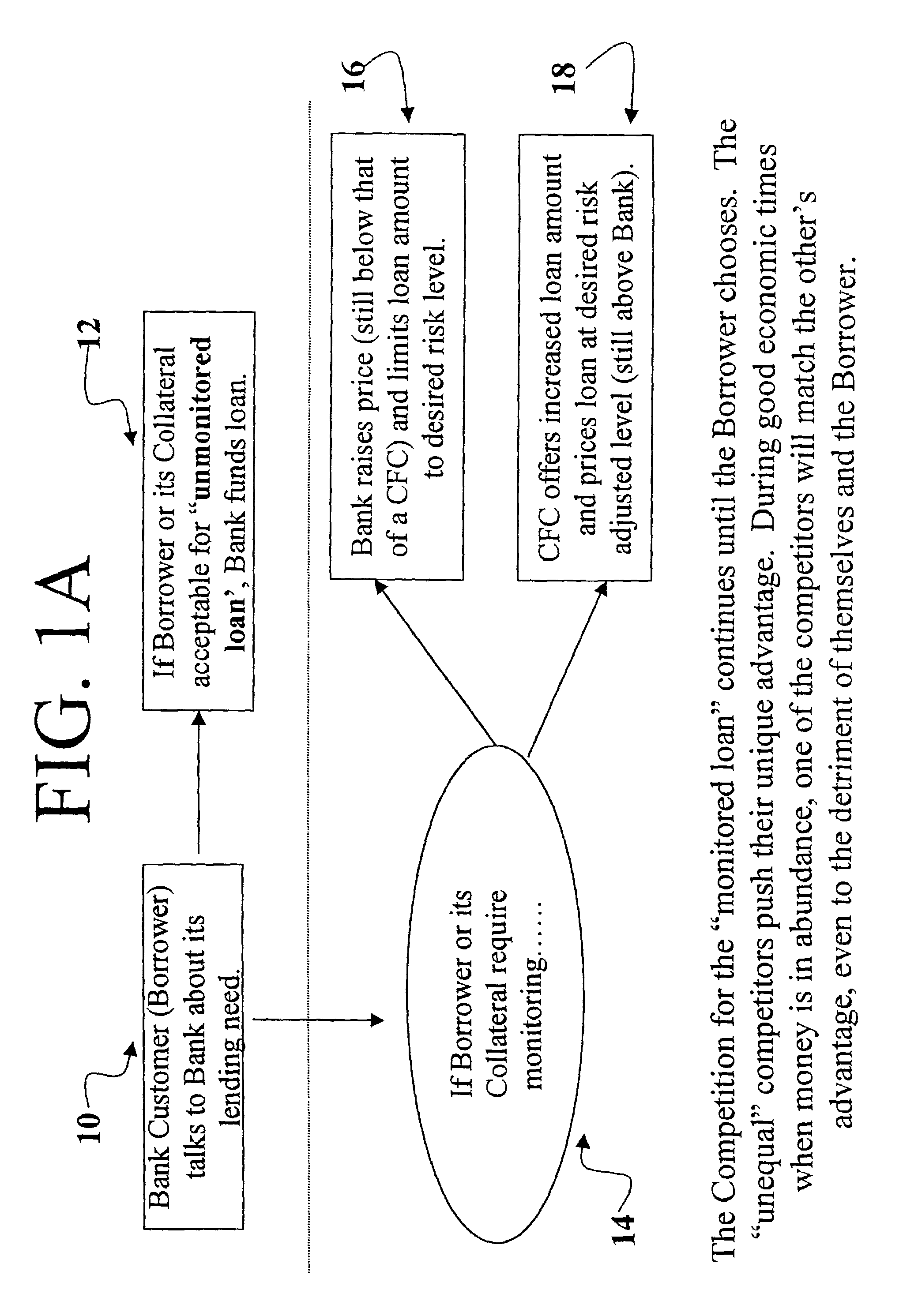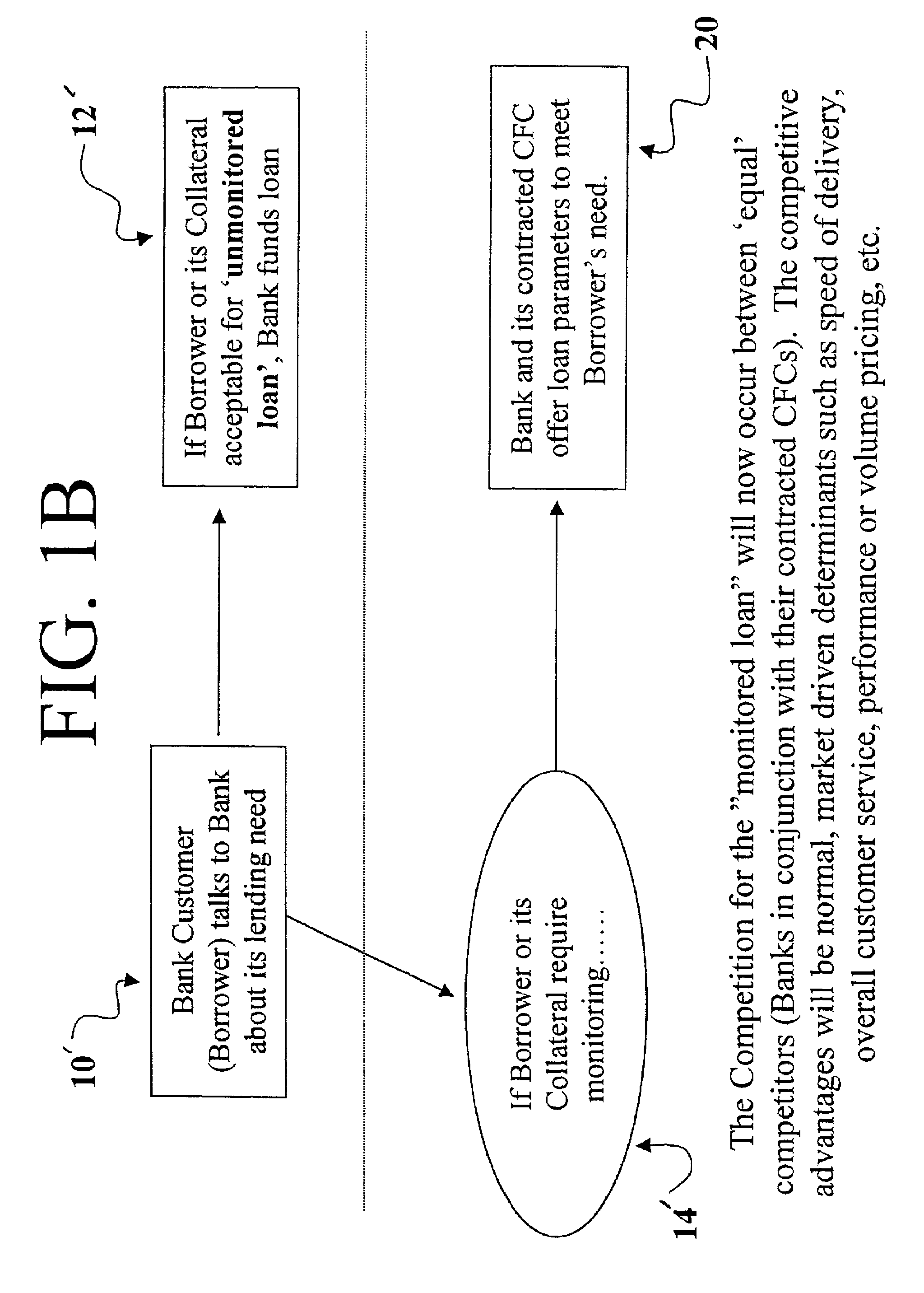[0016]The present invention is directed to all loan products not handled by or outside the expertise of an Intermediary, such as higher risk loans and niche lending, and to a
system or method for providing the loan product through an Intermediary. The invention strategically links Intermediaries and Contractors together in the distribution to Borrowers of a
single product line. The
single product line addresses all of the Borrower's loan needs while accessing the specific advantages provided by the Intermediary and the Contractor. The result is a loan product that is easier to access by the Borrower (saving the Borrower time and money in obtaining the loan product), cheaper for the Borrower (in terms of rate or cost of the loan product), less risky for the Intermediary (in terms of possible default by the Borrower), and cheaper to market and fund for the Contractor (who utilizes the marketing resources and lower cost of funds of the Intermediary).
[0017]The present invention fulfills the Intermediaries desire to provide as many financing alternatives as its Customers want, while simultaneously enhancing the Contractors desire to market and fund its products as cost effectively as possible. The resulting product obtained by the
collaboration between the Intermediary and the Contractor, fulfills the Borrower's desire to easily and cheaply access a full array of Loan products from one institution while eliminating risk for the Intermediary.
[0019]Until the present invention, an Intermediary has never been able to offer a loan product without facing any of the risk itself. By combining the biggest advantages of Intermediaries (built in marketing, and low cost of funds) and that of Contractors (loan servicing expertise), Borrowers can enjoy lower priced Loans while Intermediaries eliminate the risk and Contractors
gain marketing power at little cost. Competitors (i.e., Intermediaries in conjunction with their Contractors) will now all compete on equal footing. In this regard, competition does not get eliminated, it merely gets shuffled around so that all market participants can benefit.
[0021]As provided above, the method comprises obtaining the money provided for the loan from the first institution. Certain institutions, such as banks, typically have access to money at a low cost (as compared to that available to a commercial finance company). This step allows one or more of the parties to the transaction to benefit from such low cost. Additionally, the method includes obtaining indemnification for the first institution of all risk for providing the money for the loan. The indemnification may be obtained entirely from the second institution, or in part from the second institution with the remaining portion provided by a
third party, such as an insurance company. The
collaboration between the first institution and the second institution in this manner, allows the first institution to obtain the benefit of being able to provide the desired loan (and thus have a more complete line of products to offer) without the risk or administrative activity normally associated with such a loan. The second institution obtains the advantage of the typically greater marketing power of the first institution in reaching Borrowers. The second institution also obtains an advantage by being more price competitive by utilizing the first institutions lower cost of funds. The Borrower also obtains an advantage in being able to have easier access to all of the loan products it may require, as well as potential savings resulting from the
collaboration. Although the loan product is offered through the first institution, the loan can be made in the name of the first institution or the second institution.
[0027]In yet another embodiment the invention comprises a customer or borrower approaching its preferred Lender (i.e., Intermediary), the one that typically is easiest to access and cheapest to access, for a Loan. The Lender evaluating the needs of the customer, and identifying a Loan product not directly provided by the Lender. Because the Lender desires to service the customer's needs and not lose or damage its relationship with the customer, the method includes the Lender executing a contract for a Contractor to provide the Loan product to the customer in the Lender's name (i.e., a contracted loan). This fits in with the Contractor's desire to be made aware of customers in search of a Loan product that the Contractor provides without the expenditure required for marketing the Loan product. This so-called “Private
Label Loan Product” may be less expensive for Borrowers than going directly to the a Contractor through the Contractor's sales and marketing department. Moreover, the Loan product provides the same margin (or better) for administering Contractors, and fee income or “risk adjusted” premium yields on funds employed or both to participating Intermediaries.
[0028]The method and Loan product, provides for a customer (i.e., Borrower) to obtain a Loan from an Intermediary through a Contractor, thus saving the Contractor sales and marketing expenses. The Intermediary funds the Loan per instructions from the servicing Contractor utilizing the Intermediary's low cost of capital. The Intermediary earns a risk-adjusted premium on funds employed for providing marketing services to the Contractor or earns a straight fee income, or a combination of both. The wire fees normally incurred when the funds originate from the Contractor's
bank account, are avoided throughout the life of the Loan if the Intermediary is a
Bank. If the Intermediary is a
bank, it continues to earn interest on checking account balances of the Borrower. The Borrower's Loan costs are lower due to the expense savings and revenue enhancements provided by this method and product.
 Login to View More
Login to View More  Login to View More
Login to View More 


